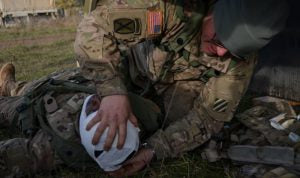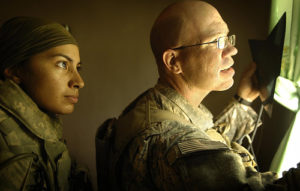With a Rise in TBI for Military Members, New Technology is Here to Help

military.com
As technology improves and more research is done, one of the most significant health concerns that continues to affect members of the military and veterans is traumatic brain injury (TBI). Active troops continue to suffer as more cases of TBI are diagnosed. TBI and concussions often occur during combat and not only negatively impact unit numbers, but soldiers’ day-to-day living as well.
The subject of TBI is currently a focal point for the United States Department of Veterans Affairs (VA), and its health care system has made it a goal to give individuals who are diagnosed with TBI the proper resources and treatment necessary.
Veterans may experience TBI throughout their lives, and those who are elderly can be particularly affected by the consequences caused by TBI.

Military.com

U.S. Army Sgt. Eric Puglio, right, of Foxtrot Battery, 1st Battalion, 41st Field Artillery Regiment, 1st Armored Brigade bandages Sgt. Derrick Rouse’s head after he received a simulated injury while conducting a react to indirect fire training scenario during exercise Combined Resolve V at the U.S. Army’s Joint Multinational Readiness Center in Hohenfels, Germany, Oct. 28, 2015.
Additionally, members of active duty and reserve service members are more likely to endure a TBI while serving the country. Research shows that younger males, between 18 and 24, hold the most risk of experiencing TBI since they are required to do operational and training activities, which are physically exhausting and possibly dangerous, on a daily basis. If a military member is deployed to an at-risk area, their chances of getting a TBI increases exponentially, especially by being exposed to combat initiatives, like explosive devices, suicide bombers, land mines, mortar rounds and/or rocket-propelled grenades.
Even in their time of leisure, active duty members may go off and partake in adventurous recreational activities, such as paragliding, mountain climbing or skydiving. All of these factors simply increase chances of sustaining a TBI.

U.S. Air Force photo by Staff Sgt. Shawn Weismiller
While the VA continues to treat cases of TBI, there is already a preventative measure that both active duty members and veterans can take. 2nd Skull is a comfortable, yet beneficial headwear that is a high-quality tested product which mitigates blows to the head. Whether it’s an active duty member who is deployed overseas, or a veteran that is taking the family off-roading, 2nd Skull products can be the protective tools to not only prevent a future injury, but could help lower the risk of getting a TBI.
2nd Skull is equipped with a thin layer of XRD—a lightweight feature made for extreme protection with the use of urethane molecules that harden under pressure.
2nd Skull has two products that are easy to wear and durable for just about anything. Its lightweight headband rests both snugly and comfortably on the head. For more extreme situations, such as combat tenures, there is a skull cap which covers the head completely. This skull cap can be worn underneath a helmet (improving its performance) or hat, adding an extra layer of protection for the head.


